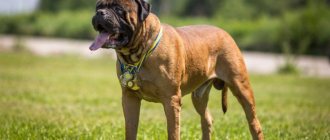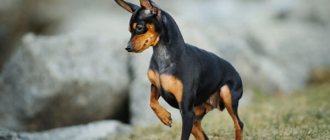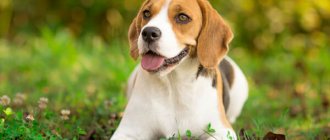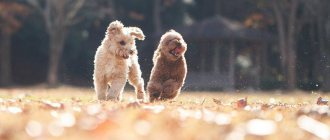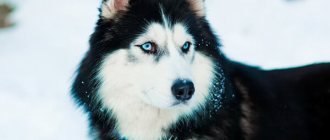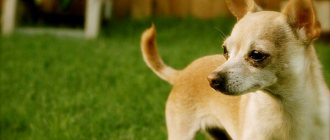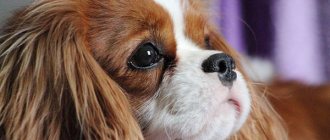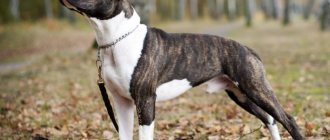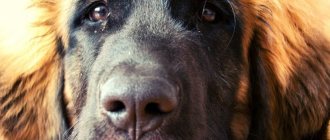Description of the Leonberger breed
Popularity 60th place among 263 dog breeds
Lifespan:
9-11 years
Breed group:
Sentinels
Height:
males: 74-80 cm, females: 61-74 cm
Country of origin:
Germany
Average price:
30-60 thousand rubles
Weight:
males: 59-77 kg, females: 61-74 kg
Latest articles Cat health
Rabies vaccination for cats: choice of vaccine, necessity, schedule 01/22/2022 15 0 0
Selection and adaptation
TOP 20 best cat breeds for families with children 01/22/2022 27 0 0
Key facts
The Leonberger is a large dog with a graceful gait. A calm and reasonable dog does an excellent job as a watchman. It is also an excellent companion for active people who prefer long walks and jogging in the fresh air.
The pet is well trained, although some disciplines, for example, agility, are not available to him.
The dog is perfect for living in families with small children. The adult will treat them like their puppies.
Leonbergers feel best in country houses, where they have the opportunity to run around the yard. But putting a giant on a chain is strictly contraindicated, since he needs to be in contact with people.
Character of the breed
Characteristics of the Leonberger include such features as
- Despite their large size, they are very kind and obedient. All orders of the owner are carried out unquestioningly.
- They are very calm. They can adapt to any owner.
- This dog breed gets along well with children. But only an adult dog.
Leonberger puppies may not intentionally drop a child or bite. When purchasing a puppy for a family with small children, there is no need to leave the dog alone with the child.
Does not conflict with other pets. But it is better not to take two Leonbergers into the house. It’s just that the owner will be superfluous here. They will be friends with each other, but will not notice the owner and fulfill his requests.
If there is still a need to take two Leonbergers, then first you need to take one and train him. The first one must begin to obey the owner. Only after training can you bring a second Leonberger into your home.
- They perform well in guard duty. At the same time, it does not make too much noise.
- Despite their sweet nature, they are good bodyguards. They will protect the house and owner in any situation.
- Not afraid of noise at all.
- Not an aggressive dog with household members.
- They require a lot of communication. They begin to get bored without attention. They love to be with their family. They don't like quarrels. Leonberger would become a lifelong friend.
- They will not make noise or bark over trifles. Only if something happened.
History of the origin of the Leonberger breed
The breed got its name in honor of the city of Leonberg, located in Germany. Experts have not reached a consensus on the origin of this large individual. There are 2 versions, each of which has certain confirmations:
- The mayor of Leonberg, Henry Essing, is considered the first creator of the breed. As an experienced dog breeder, the official decided to breed a breed that would become a symbol of the city and would be most similar to the lion depicted on the city's coat of arms. Initially, he was crossed with a black and white Landseer and a St. Bernard, and a little later a white Pyrenean dog was involved in the mating.
- The second version says that the breed existed long before this. There is evidence that large dogs similar to the Leonberger were sold at fairs in the 16th century. The animals were in demand among farmers and shepherds, for whom giants became indispensable helpers. They were also guards and carried heavy loads.
Be that as it may, pets have become widespread. In addition, they became popular among noble people. For example, the French Queen Marie Antoinette owned several dogs of this breed. At different times, the dogs were owned by the Prince of Wales, Napoleon III, Elizabeth of Bavaria, Princess Golitsyna, and Nicholas II.
Overall, the 19th century was a difficult time for the Leonbergers. Their population practically disappeared due to the plague, which claimed the lives of not only people, but also animals.
It was then that Mayor Essing appeared, who, if he did not create a new breed, then made every effort to restore the old one. To do this, he used the surviving dogs and crossed them with other breeds, making the Leonberger breed even better.
“The first dog he bred had a silver-gray color. Only a few years later they managed to get a yellow-brown dog, which really began to resemble a lion.
The puppies were actively advertised. Famous people, politicians, and aristocrats received them as gifts. The breed began to rapidly gain popularity.
After Essing's death, decline began again. The fact is that the breeder did not have documents that would establish a uniform standard of individuals. Confusion began, as a result of which a variety of dogs began to be passed off as Leonbergers.
A single standard appeared only at the end of the 19th century. After this, breeding of purebred animals began.
In Russia today this breed is considered quite rare, but its popularity is growing rapidly. The Leonberger dog breed currently numbers about 20,000 individuals.
Leonberger appearance
General impression
The large fluffy furry is striking in its size, which causes some concern at first glance. However, if you look into his kind eyes, fear immediately recedes. Dogs have pronounced sexual dimorphism. Because of this, the female can be easily distinguished from the male by her less shaggy “collar” and “pants.” And the dimensions of girls are quite modest compared to the parameters of boys.
Head
The head is large, the forehead is slightly convex. The transition to the muzzle is long and smooth. Stop moderate. The muzzle is elongated but not sharp. And the giant from Germany can boast of a real Roman profile.
Nose, eyes and ears
The color of the oval-shaped eyes varies from sandy to black. The impressive nose ends with a massive lobe. According to the standards, it must be black.
Teeth and bite
An adult is the proud owner of 42 strong, snow-white teeth. According to the breed standard, the animal has a scissor bite.
Neck
The powerful neck is completely covered with strong, dry muscles. This part of the body has an elongated shape, smoothly turning into a massive withers.
Torso
The Leonberger's build is strong but harmonious. The wide back has no arches. The withers are prominent, with a massive, slightly rounded croup. The oval chest is wide. It almost reaches the elbows. The abdominal part is slightly tightened.
Forelegs
Legs with strong muscles are located parallel. The shoulder blades are elongated, with a slight slope. The elbow joints are pressed to the body.
Hind limbs
The legs have dense thighs with angular shins. Strong hock joints set at an angle. Paws with dark pads are collected in a ball.
Tail
The tail part is covered with long hair. At rest, this part of the body is lowered. However, during movement, the tail is curled and raised, but not higher than the back.
Movements
Leonberger moves through the territory quickly, but at the same time very elegantly. Its strong skeleton allows it to travel long distances.
Wool
A feature of the breed is its long and dense coat. It is characterized by water-repellent properties and can be slightly wavy. The pet has a luxurious thick undercoat. The longer hair is located on the back of the neck.
Color
German robust dogs can have different color options: yellow (lion), sand, red, reddish-brown. A black mask on the face is required. The standards allow white marks on the chest, as well as light hairs on the paws.
Size
The Leonberger is a large breed. The height of males ranges from 71 to 80 cm, the height of females usually does not exceed 75 cm. Dogs weigh 55-77 kg, females - from 45 to 60 kg.
Disqualifying faults
Taking photos of Leonbergers, professionals can immediately identify deviations from the norm. Here's what a future pet owner should pay attention to:
- brown paw lobes and/or pads;
- muzzle without the characteristic black mask;
- tail always bent like a donut;
- coat is too wavy;
- uncharacteristic eye color;
- large white spots or in an inappropriate location;
- incomplete set of teeth.
A serious violation is the anatomical deformation of the body. A disqualifying defect will be a back with a bulge or a hump, as well as limbs with a “cow” posture.
Leonberger character
Representatives of the breed are distinguished by their calmness and equanimity even in those moments when there is chaos and panic around them. A balanced dog has a sweet disposition and is not inherently aggressive. However, his good-natured nature will not prevent him from protecting his master or his family members if necessary.
“People are the most important thing for Leonberg. He feels responsible for his family and tries to keep everything under control, while remaining unobtrusive.
The omnipresent giant is always aware of events. He sincerely loves everyone, and it is impossible not to reciprocate his feelings. Good-natured individuals make excellent companions.
But the change of owner is very difficult for the pet. Stress can change his behavior beyond recognition.
The dog treats strangers quite calmly, without showing excessive negativity or aggression. Therefore, the shaggy pet is good as a guard dog.
He usually chooses a place from which he has a good view of his possessions and is on duty at all times. You can safely entrust Lenberger with both the protection of property and your own safety.
Animals rarely bark. Yes, this is not necessary. After all, the sight of them is usually enough to make the attacker forget why he came.
“A smart dog is able to independently assess the situation and understand whether the use of physical force is necessary.
Representatives of this breed can easily tolerate very loud sounds: thunder, gunshots, firecracker explosions. This ability is innate in them.
Pros and cons of the breed
pros
- Could be a watchman.
- They obey the owner. They fulfill his requests.
- They love children.
- They are in good health.
- Non-aggressive.
Minuses
- They cannot live in apartments. They need room to move.
- The coat requires constant brushing.
Leonbergers are very cute dogs that resemble a lion. They need to be trained from early childhood.
Only through proper training and socialization will they become reliable guards.
Education and training
The non-conflict and gentle nature of Leonbergers is not a reason to refuse training. The animal needs this just like other breeds.
Early socialization plays an important role. The puppy must understand that in the world, besides him, there are many more people who need to be treated correctly.
An active and restless puppy must immediately learn the rules of behavior in the house and on the street, and understand the boundaries of what is permitted. At the age of 2-3 months he is already quite ready for this. When socializing Leonbergers, a lot of repetition is not required, and the beefy one understands everything basically the first time.
Serious training can begin when the puppy is 5-6 months old. The peculiarity of representatives of this breed is that they are very easy to train. The lack of desire for dominance makes the dog obedient; it happily follows the owner’s commands. Some trainers believe that you need to speak to a giant in human language, letting him know that you are on the same level as him.
An imperative tone and strict command are completely inappropriate. A rational animal will not tolerate beatings because of its well-developed sense of justice.
You must communicate with the animal calmly and patiently, treating it with due respect. High intellectual abilities help the dog understand whether it was fairly punished. Therefore, try to avoid punishment. The animal may harbor a grudge.
Looking for a Leonberger? Find your pet from 2 offers As a gift
Leonberger training and training
- You need to be socialized from childhood.
- Training should begin when the Leonberger is three months old.
- Punishment during training is prohibited. You only need to train using his favorite treats. Usually the dog obeys. Tries to fulfill the owner's requests.
- Training is slower due to the fact that they themselves are slow. Having heard from the owner what needs to be done, they will not run to do it, they will first think about how best to do it and then only fulfill the request or command.
You can train them simply by changing the tone of your voice. By the intonation of the owner, they already understand what they want from them.
Leonberger health and diseases
Possible diseases
Leonbergers are fairly healthy dogs. Unfortunately, like many giant-sized breeds, it has a shorter lifespan than most others. On average they live 9-10 years.
All purebred dogs are prone to certain health problems more than others, and Leonbergers are no different. Some pets may suffer from one or several ailments. Here are the most common diseases found in this breed:
- Joint dysplasia is a common problem in large and giant breeds. Heredity plays a big role here, so it is important to breed only dogs with good performance. Large individuals take a long time to develop, which can lead to uneven growth. This causes additional wear and tear, which eventually leads to arthritis. Pets that have difficulty sitting or standing, climbing stairs, or moving around easily need treatment.
- Leonberger is susceptible to various vision problems. The most common are progressive retinal atrophy and age-related cataracts. Symptoms of eye disease include bumping into objects, watery eyes, redness and increased itching.
- Hypothyroidism is an endocrine disorder caused by low levels of hormones. There is no cure, but dogs with this condition can lead normal lives with the help of medication. The main symptoms are lethargy, weight gain, brittle hair. Breeders should test their pets for this disease and not breed those suffering from this disease.
- Polyneuropathy. There are two types of disease that affect the breed. And to identify them, two DNA tests are required (LPN 1 and LPN 2). It is an inherited neuromuscular disease caused by the degradation of nerve fibers in the body. Symptoms include unsteady gait, exercise intolerance and difficulty breathing. Symptoms usually appear between the ages of two and four years. Again, a dog with this condition or carrying the mutated gene should not be used to reproduce.
In order for your four-legged friend to please you for as long as possible, you should pay a lot of attention to him. Keep him active with exercise, feed him the best quality food, and visit your veterinarian regularly.
Reproductive health and breeding
Like most large individuals, sexual maturation in the Leonberger occurs with some delay. A bitch can be mated no earlier than she is 2-2.5 years old. Earlier reproduction of offspring can lead to physiological and psychological problems in the female.
Features of feeding and diet
In the first days, when the puppy has just appeared in the house, it is recommended to feed him the food that he ate from the breeder. This will reduce the baby's stress because at least something familiar will remain in his life.
In the future, the owner will have a choice: to feed with natural food or industrial food. Both types of feeding have both pros and cons, each has its fans.
When feeding dry food, you need to choose only high-quality food, without skimping on your pet’s health. You should pay attention to super-premium and holistic class products.
“ When feeding naturally, you need to create a balanced menu, thanks to which the dog will receive all the necessary vitamins and minerals.
When feeding natural food, a large animal must eat lean meat, fish, pre-deboned fish, offal, eggs, low-calorie dairy products, boiled and raw vegetables.
What you should not feed your Leonberger:
- river fish;
- tubular bones;
- fatty meat and offal;
- baking;
- sweets;
- berries and citrus fruits.
Owners of representatives of the Leonberger breed leave reviews that their pet eats very little, despite its large size. Some owners claim that the taste preferences of dogs of this breed can change frequently.
Price of puppies
The price of a Leonberger varies from 30,000 to 50,000 thousand rubles. The breed is not that common.
Therefore, you can’t buy them everywhere. Where to buy a Leonberger dog? They can be purchased from breeders or special nurseries.
Care and maintenance
Walk
Like any large breed, Leonbergers need long walks. Moreover, it is desirable that these are active walks. Games, jumping and running help the giant develop properly and maintain shape.
For walks, the owner needs to choose a deserted place. A four-legged friend let off a leash can throw out all his energy and even scare random passers-by. It is recommended to keep your pet on a leash in public places.
Leonberger simply loves water and will not miss the opportunity to swim if he is near a body of water. This should be taken into account when planning your walking route. It is interesting that when a dog sees a person bathing, he will immediately rush to save him.
The ideal would be to keep a dog of this breed in a private house, where a spacious enclosure can be allocated for the animal. But today Leonbergers are often residents of city apartments, where they feel quite comfortable.
The dog should feel like a member of the family; daily contact with people is vital for him. Keeping your pet chained or locked up separately would be a terrible blow to your pet.
Hygiene
The main attention will have to be paid to pet hair. The dog sheds twice a year - at this time it will have to be brushed every day, otherwise mountains of hair will remain on the floor of the living room. At other times, it is enough to brush your pet once a week. For this procedure, it is better to buy several combs and brushes.
Although Leonbergers love water, it is not recommended to bathe them often. This is only done when the pet is heavily soiled. For this procedure, you will need to stock up on special shampoo, plenty of towels and patience. Bathing takes a lot of time.
In order to dry the coat after the water procedure, you can use a hairdryer. It is best to turn on cold air. Hot temperatures negatively affect the dog's coat, making it brittle.
You should pay attention to the eyes and ears of your four-legged friend. They need to be treated weekly with special solutions or warm boiled water.
To prevent plaque formation, you need to brush your dog’s teeth or give him a special treat. Claws are trimmed if the animal does not polish them naturally when walking and running.
Tips for choosing a puppy
Before making a final decision on purchasing dogs of this breed, you need to weigh the pros and cons. Of course, the Leonberger has a great character and makes a great friend. But can you give your pet enough time?
And are the living conditions suitable for keeping a large pet? Indeed, if there is not enough space in an apartment or house, everyone will suffer: both the owner and the four-legged friend.
For those who have decided to purchase one, they must approach the choice of a puppy very responsibly. To begin with, you can visit several exhibitions to be able to see the dog in all its glory. Often, just a photo of a Leonberger is not enough to decide on the choice of breed.
Be sure to read reviews of nurseries where Leonbergers are bred. This is important in order to subsequently cast aside any doubts about the purity of the breed and get a healthy puppy.
Experienced dog breeders recommend finding free time to come to the kennel and watch the babies and their mother. You need to pay attention to a curious little dog who makes good contact. The puppy must be active and well-groomed.
The breeder must present documents confirming the purity of the breed and the absence of hereditary diseases.
Don't be shy to ask questions to the breeder. A responsible seller is interested in ensuring that his babies end up in good hands. Be sure to check that the puppy has a veterinary passport and vaccination records.
Teffills
Before you become the happy owner of a puppy of this wonderful breed, read reviews about Leonbergers on the Internet, go to exhibitions to see the dog of your dreams “live”. If, after looking at a photo of a Leonberger, you fell in love with this breed, then meeting them will give you even more joy and positive emotions.
Weigh all the pros and cons: keeping such a giant is quite expensive, in addition, it is not recommended for a Leonberger with his chic, thick “fur coat” to live in apartments; this dog needs space and fresh air. Adequately assess your financial capabilities for raising a puppy and keeping a giant dog, whether you can provide your future friend with decent housing in the house and an area for relaxation and play in a shady area nearby.
The Leonberger is an ideal breed for a large happy family living in a separate house with its own plot!
Where the dog will be comfortable and train in being useful to the family, and relax quietly under the shade of trees.
Don't get a dog if you can't keep it. Don't breed a bitch if you can't sell or donate the puppies. Do not start your own business if you are not 100% sure of paying off all costs...
How to purchase a puppy in our kennel:
1. You can choose a puppy in the kennel after activation, starting from 6 weeks, until 6 weeks we grow quietly, not thinking about new hands and new homes, thinking only about the babies and their mother, paying them attention around the clock, surrounding them with care, perhaps taking you into account verbally, I do not reserve puppies from diapers at suckling age, with my eyes still closed, when the picture of development is not entirely clear to you, give us a little time to get on our feet and see the development of puppies more clearly to me and appear to you in all its glory , so that you see a clearer picture when choosing. During this time, while the kids are growing, you can be in touch to convey to me that your intention to purchase a puppy is serious and responsible. And perhaps during this time we will find mutual understanding and trust in each other to friend.
2. A deposit is paid for the selected puppy, the puppy is marked by me, after activation, all babies have brands in the ear, you can remember your baby by the number of the brand. 3. The date of registration of puppies according to the breeding regulations of the RKF is 45 days. During certification, the puppy is branded, a puppy card is created on it, in which the name, brand, parents and date of birth are entered. In the future, it is exchanged for a pedigree at the RKF office in Moscow. During activation, each puppy is examined by a dog handler and a litter-wide card is filled out. If there are anomalies or defects in the puppies, the dog handler records his comments in the general litter card and makes a note in the puppy card. 4. The puppy can be picked up at 8-9-10 weeks, not earlier, depending on the timing of vaccination, but you must provide your puppy with the proper conditions to allow it to pass quarantine safely. Having agreed on the timing of vaccinations with me, 10 days after revaccination you can start walking (if everything is in order at the age of 3-3.5 months).
5. I prefer to release puppies to new homes only at a safe age for them, no earlier than 8-9 weeks, at the age of 8 weeks the first vaccination is given, a week is quarantined after it to observe the body’s reaction after the first vaccination, if the temperature is normal, appetite and stool are normal, the baby is active and playful, then you can begin to prepare for the meeting with the new parents of the puppy, but do not forget from street walks, we also abstain in the new home until the quarantine passes after revaccination.
6. The puppy, leaving its parental home, receives from me: a puppy card, a veterinary passport with a note about the next vaccination; an individual memo (where I write down my recommendations for feeding and rearing), with telephone numbers and addresses of veterinarians and clinics, if you live in the same city; with an agreement (oral or written) at the request of the owner; the usual food for the puppy upon arrival, although in general, many future owners prepare in advance for the baby’s arrival and the food is already ready, waiting in the wings, all this is discussed, what needs to be prepared for the baby’s arrival, and I am left not only with the money you left in as gratitude for keeping and raising your puppy, but also with a pain in the heart about what the fate of the baby will be and how responsible its future owners will be to the child. 7. Each puppy in my house is examined first of all by me constantly, then each puppy is examined before vaccination by a veterinarian whom I call to the house. During activation, the puppy is also examined by a dog handler. The last time my puppy is examined by the buyer (very carefully) before going out into the world. 8. In my house, the puppy is dewormed 3 times: at 3, 5 and 7 weeks. The most effective anthelmintic is chosen. Worms must be driven away more than once. Don't believe claims that puppies and adult dogs don't have worms. Puppies become infected with worms in utero. Unfortunately, when buying an expectant mother somewhere and from someone (provided that worms were unscrupulously driven away in that house), you will encounter a problem in the future. If the bitch is not given anthelmintics up to 5 weeks, the larvae subsequently become encapsulated in the soft tissues and, under certain conditions, enter the uterus. Subsequently, by driving away the worms, you will kill the sexually mature ones, and those encapsulated in the uterus will lie dormant until pregnancy. With renewed vigor, the worms will reproduce during pregnancy and infect future puppies in utero. If the puppy has not been dewormed, he may have health problems and may face complications during vaccination (intoxication is possible). Anthelmintics are given 7-10 days before each vaccination. 9. Sometimes conflict situations arise. They bought a puppy from you, it was examined by a veterinarian, the future owner, but for various reasons its fate did not work out. And then mutual reproaches appear. It seems to you that the puppy is being raised in the wrong way, and to the buyer that the puppy was purchased sick and genetically poor. STOP. Let's figure it out. I consider myself a very meticulous breeder of my puppies. I love and cherish them, I sleep in the same room with them for the first month, being around them around the clock, conscientiously caring for them and socializing them. When I give puppies into the hands of others, I want their lives to be happy, because all the prerequisites for this were in place. I am ready to communicate with every buyer day and night and give advice. But..People take a puppy into their home, not always imagining what difficulties they may encounter. You need to grow it wisely. First and foremost - take care of the puppy! People tend to rush from side to side. Without listening to the breeder, people who are far from this breed are involved in raising puppies. Any advice is accepted, just not what is needed. Human doctors are used to the fullest (a human doctor can instantly transform into a veterinarian - after all, the anatomy is different). And the food. Recommendations are forgotten, and the puppy becomes a testing ground for testing various types of feeding, tasting brands of all kinds of food. The (mutual) reproaches are increasing, and the puppy is getting worse. Very often, a puppy is adopted by people who already had a dog, or have an old and sick dog. They are accustomed to illnesses, so they believe that they know everything in advance, and treat the puppy as a weak, defenseless creature, blowing off specks of dust from it, limiting it from the necessary stress. Don't get a puppy if you can't raise it to be a big, strong, healthy dog. A puppy is not a momentary whim, it is work. Everyday, hourly, sometimes hard, but very exciting and beloved work together. 10. Don't forget about socialization and training of the puppy. A well-mannered puppy is comfortable for you and your family. Explain to him the rules of your life and routine in a puppy-friendly language. Be patient and tactful. The Leonberger is a dog that does not tolerate rough handling well, do not break it. Negotiate with your dog, it's worth it.
NO SELF-RESPECTING BREEDER WILL BE ABLE TO PREDICT MANY THINGS IN A SMALL PUPPY: unfortunately, the breeder is NOT CLAIRVOYANT...
Dear friends, possible future buyers, this is just for you!
1. PUPPIES ARE NOT BORN ELITE.
ADULT DOGS BECOME ELITE based on the quality of the offspring born from them (previously, this title was assigned to a bitch and a male based on the quality of the offspring exhibited at the exhibition. For both a male and a female, the number of offspring from different matings is different, so parents of puppies could only receive the title ELITE upon reaching the age of three years for a male and four years for a female.) - heard at a cynology course :)
2. SHOW IS NOT BORN A DOG, BUT BECOME
only based on exhibition success and only after 9 months, when the puppy moves to the junior class. Showing a puppy in the puppy and baby class is good training for the future champion, provided that after he has grown from puppy to junior, his teeth have changed correctly, his bite is normal, his height is standard, so that he has not overgrown or undergrown, height in the standard, and in juniors it can be at the upper limit in the standard, but in the intermediate or open class it is not as mature as required in the standard and that’s it, no longer for exhibitions, they will be removed for being undersized - overweight or overweight or underweight, which If only the dog weren't beautiful.
For a show dog, show charisma is needed and temperament is very important, not all dogs are capable of this, they are prepared and taught specifically for exhibitions, children also did not immediately begin to write, read and count, they were taught this. Exhibitions for dogs are the same school as for children, and for service breeds the main school is training in OKD, etc., and exhibitions are in the background.
THEREFORE, A RESPECTABLE BREEDER CAN ONLY ASSUME AND WRITE THAT THE LITTLE PUPPY IS CURRENTLY WITHOUT DEFECTS AND IS SUITABLE FOR SHOWING AND BREEDING IF DESIRED, but to assert this at 2-3 months that this show-class puppy will be a star of the ring is considered too self-confident approval by the breeder.
3.IF YOU WANT A REALLY SHOW DOG OR A DOG WITHOUT DISADVANTAGES FOR BREEDING—
YOU SHOULD ONLY TAKE A GROWN DOG NOT EARLIER! 10 MONTH (after changing all the teeth), but you may already be a stranger to a dog at that age, do not forget, dogs are very loyal animals and the owner of this already grown-up dog will remain the one who raised it until these 10 months... do you need a show hero with longing in his eyes for his former owner and his usual place... as they say, the sooner, the better for a little puppy to get used to a new home and a new owner (although at this point not everything is so clear - adult dogs also came to us personally; unfortunately, they were left without an owner on the street:((((and they were very grateful to our attention and care...the stress from the new place and the new owner was minimal, again, if you make an effort and create the best conditions, investing your soul.
If you need a dog for breeding, many people start with this very condition: we need a dog! Nice show dog! Need a show class dog for breeding! Then, even after the exhibition, and after he has been untied and wait for the bitch to be pregnant from him, look for such a skillful and high-quality sire
